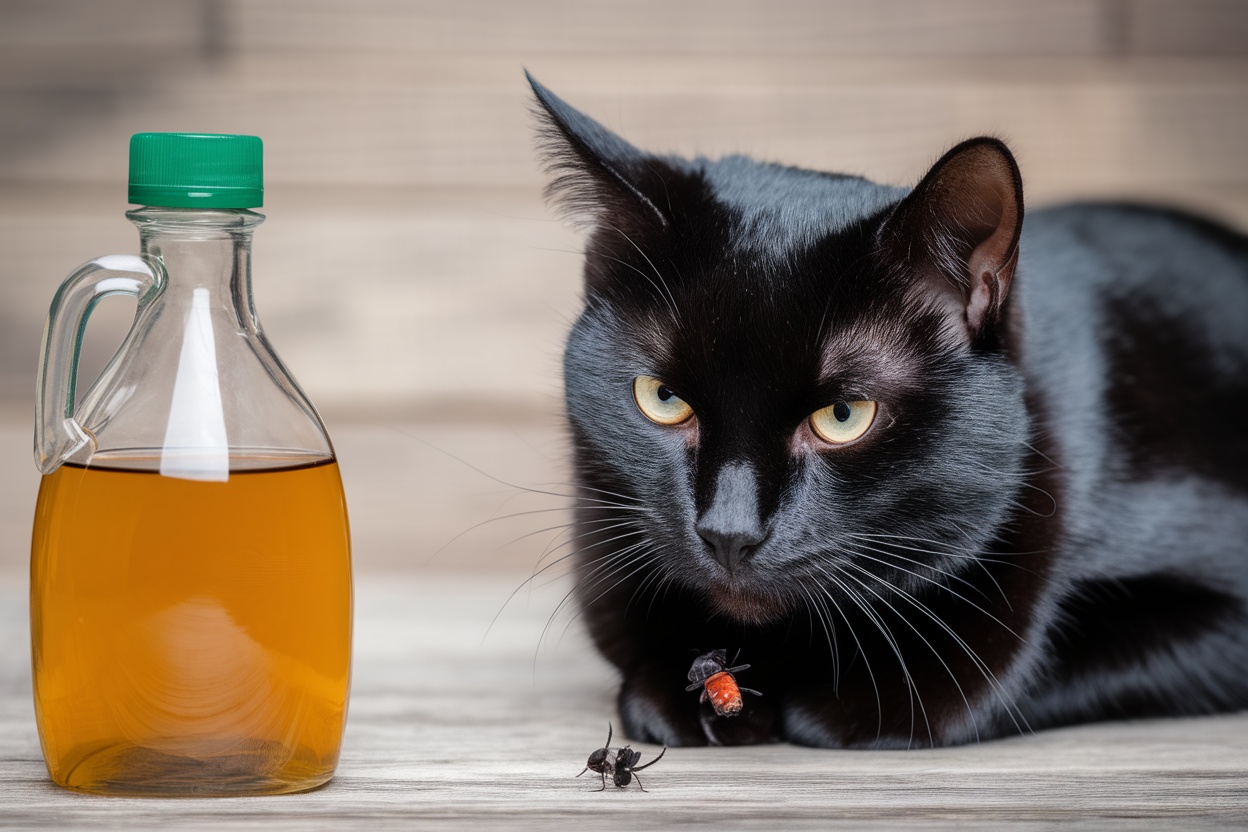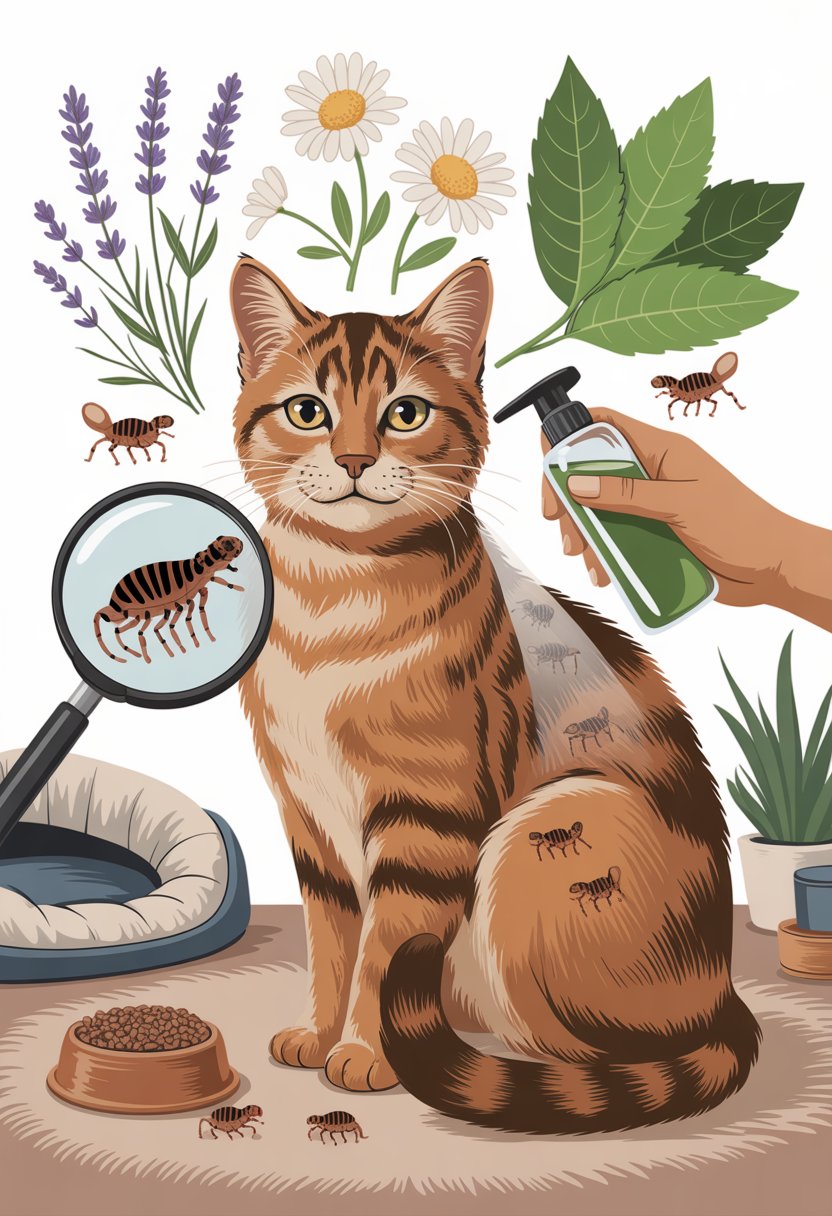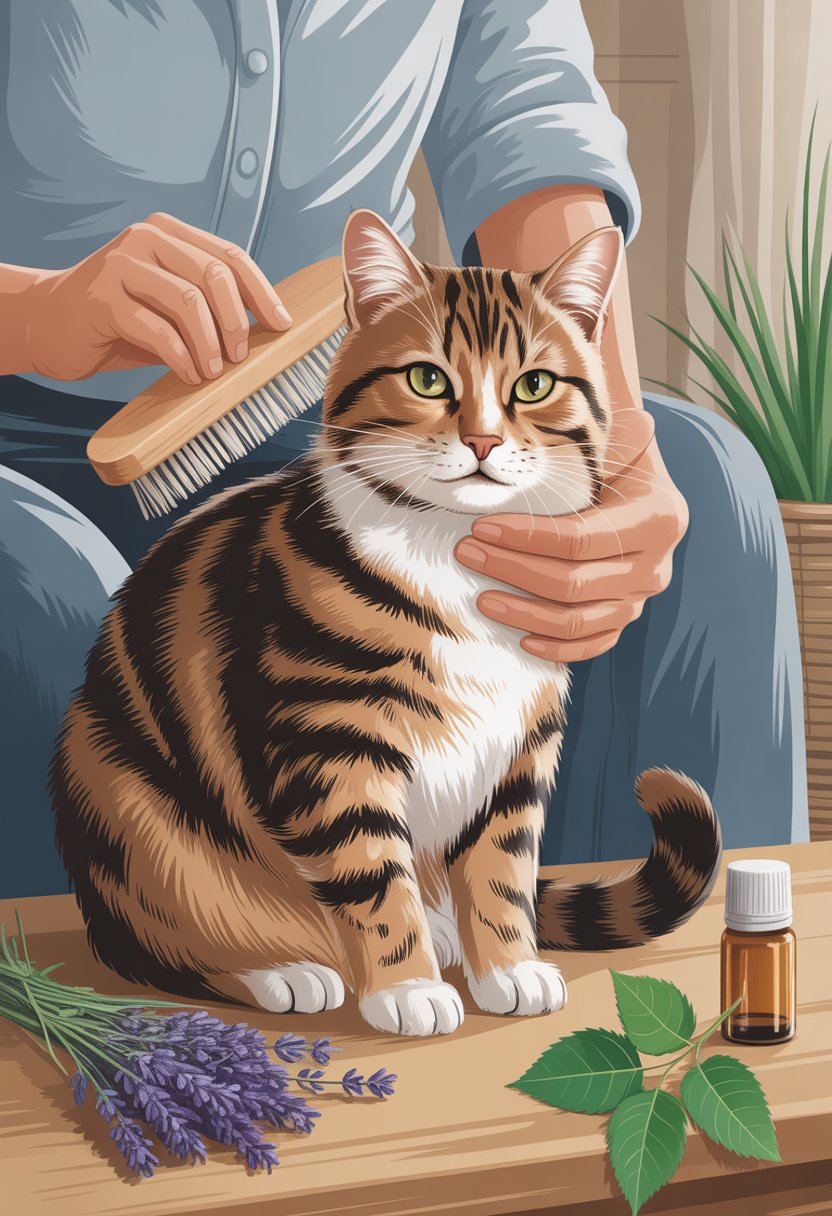
Fleas can make your cat’s life miserable, but you don’t have to resort to harsh chemicals to solve the problem. Natural flea treatments for cats like lemons, cedar, and essential oils can help manage infestations safely when used correctly.

Your cat’s comfort depends on understanding how fleas work and what natural options actually fight them. Many pet owners worry about using strong flea products on their cats, especially older cats or those with sensitive skin. The good news is that effective natural remedies exist.
This guide will walk you through proven natural methods to eliminate fleas from your cat and home. You’ll learn how to spot flea problems early, use safe home treatments, and create an environment that keeps fleas away. We’ll also cover how to boost your cat’s natural defenses against these pests.
Understanding Fleas on Cats
Fleas are small, blood-sucking parasites that jump onto cats and multiply rapidly through a four-stage life cycle. These pests spread easily between animals and leave behind flea dirt as evidence of their presence.
Life Cycle of Fleas
Fleas go through four stages: egg, larva, pupa, and adult. The entire cycle takes 14 to 21 days under ideal conditions.
Adult fleas lay flea eggs directly on your cat’s fur. These white, oval eggs are tiny and fall off your cat onto carpets, bedding, and furniture.
The eggs hatch into larvae within 2 to 5 days. Larvae are small, worm-like creatures that feed on organic matter and flea dirt in your home.
After 5 to 11 days, larvae spin cocoons and become pupae. This stage lasts 3 to 5 days before adult fleas emerge.
New adult fleas immediately seek a host to feed on. They can live up to 100 days on your cat if conditions are right.
How Fleas Spread in Cats
Fleas spread through direct contact between animals. Your cat can pick up fleas from other cats, dogs, or wild animals.
Fleas also live in your environment. Your cat can get fleas from infested areas like yards, parks, or other homes.
Indoor cats can still get fleas. You might bring them in on your clothes or shoes. Fleas can also enter through open doors and windows.
Once one flea gets on your cat, flea infestations develop quickly. A single female flea can lay 50 eggs per day.
The eggs fall off your cat and hatch throughout your home. This creates a cycle where new fleas keep appearing even after treating your cat.
Common Signs of Flea Infestation
Excessive scratching is the most obvious sign of fleas. Your cat will scratch, bite, and lick affected areas more than usual.
Flea dirt appears as small, dark specks in your cat’s fur. This is actually flea feces that turns red-brown when wetted with water.
You might see small, fast-moving brown insects jumping on your cat. Adult fleas are about 1/8 inch long and move quickly through fur.
Hair loss and red, irritated skin develop from constant scratching. Some cats develop small scabs or hot spots from scratching.
Your cat may become restless and uncomfortable. Severe infestations can cause pale gums from blood loss, especially in kittens.
Identifying and Managing Flea Infestations

Spotting flea problems early helps you protect your cat from discomfort and health issues. You can identify fleas by looking for specific signs like flea dirt, eggs, and changes in your cat’s behavior.
Detecting Flea Dirt and Eggs
Flea dirt looks like tiny black or brown specks on your cat’s fur. These specks are actually flea waste that contains digested blood. You can test if dark specks are flea dirt by placing them on a wet paper towel – they will turn reddish-brown if they contain blood.
Check areas where fleas like to hide:
- Base of the tail
- Behind the ears
- Under the arms
- Belly area
- Between the toes
Flea eggs appear as small white or cream-colored oval shapes. They are about the size of a grain of salt and often fall off your cat onto carpets, bedding, and furniture.
Use a fine-toothed flea comb to help detect both flea dirt and eggs. Comb through your cat’s fur slowly and look for moving fleas or the dark specks that indicate their presence.
Recognizing Symptoms in Cats
Cats with fleas show several clear warning signs. Excessive scratching, biting at the skin, hair loss, redness, and small black or brown dots on your cat’s coat are common indicators of flea problems.
Watch for these behaviors:
- Constant scratching or licking certain areas
- Restlessness during sleep or rest
- Hair loss in patches from over-grooming
- Red, irritated skin especially around the neck and base of tail
Some cats develop flea allergy dermatitis, which causes intense itching from flea saliva. This condition makes cats scratch much more than normal and can lead to open sores.
You might also notice your cat seems tired or less active than usual. Heavy flea infestations can make cats feel uncomfortable and stressed.
Dangers and Health Risks for Cats
Flea infestations create serious health problems for cats beyond just itching. Heavy infestations can cause anemia, especially in kittens, elderly cats, or cats with weak immune systems.
Major health risks include:
- Anemia from blood loss
- Skin infections from scratching
- Flea allergy dermatitis
- Transmission of parasites like tapeworms
- Secondary bacterial infections
Kittens face the highest risk because their small bodies cannot handle significant blood loss. Anemia symptoms include pale gums, weakness, and lethargy.
Fleas also carry diseases and parasites that can spread to your cat. Tapeworms commonly spread through flea bites when cats groom themselves and accidentally swallow infected fleas.
Open wounds from scratching can become infected with bacteria. These infections may require antibiotic treatment and can become serious if left untreated.
Core Natural Flea Remedies for Cats
Several proven natural methods can help control fleas on cats, including topical treatments with diluted essential oils, oregano oil containing carvacrol, and proper bathing techniques that remove fleas without harsh chemicals.
Natural Topical Treatments and Sprays
You can create effective flea sprays using common household ingredients. Apple cider vinegar mixed with water works as a natural deterrent when sprayed on your cat’s fur.
Mix one part apple cider vinegar with three parts water in a spray bottle. Test a small area first to check for skin reactions.
Diatomaceous earth provides another topical option that kills fleas through physical action. Use only food-grade diatomaceous earth around your cat’s bedding and living areas.
Key Application Tips:
- Apply sprays between shoulder blades where cats cannot lick
- Avoid eyes, nose, and mouth areas
- Reapply every 3-4 days for best results
Always consult your veterinarian before starting any topical treatment. Some cats have sensitive skin that may react to natural ingredients.
Oregano Oil and Carvacrol
Oregano oil contains carvacrol, a compound that naturally repels fleas. This ingredient disrupts flea nervous systems and prevents them from staying on your cat.
Carvacrol must be heavily diluted before use on cats. Mix 1-2 drops of oregano oil with 1 tablespoon of carrier oil like coconut oil.
Proper Dilution Ratios:
- Oregano oil: 1-2 drops
- Carrier oil: 1 tablespoon
- Water: 1 cup for spray application
Apply the diluted mixture to your cat’s collar area or behind the ears. Never use undiluted oregano oil directly on cats as it can cause skin irritation.
Test on a small patch of skin first. Watch for redness, itching, or other reactions for 24 hours before full application.
Safe Use of Essential Oils
Essential oils like lavender and cedarwood can repel fleas when used correctly. Cats are sensitive to many oils, so proper dilution is critical.
Safe Essential Oils for Cats:
- Lavender (heavily diluted)
- Cedarwood
- Chamomile
Oils to Avoid:
- Tea tree oil
- Eucalyptus
- Peppermint
Always dilute essential oils to less than 1% concentration. Mix 1-2 drops with 2 tablespoons of carrier oil or water.
Apply diluted oils to areas your cat cannot reach by licking. Focus on the back of the neck and between shoulder blades.
Stop use immediately if you notice excessive grooming, drooling, or skin irritation. Some cats are more sensitive than others to natural oils.
Bathing and Cleaning Practices
Regular bathing with mild dish soap can physically remove fleas from your cat’s fur. Dawn dish soap works well because it suffocates fleas without harsh chemicals.
Fill a tub with lukewarm water and add a few drops of dish soap. Wet your cat thoroughly and work the soap into a lather.
Effective Bathing Steps:
- Wet fur completely with warm water
- Apply small amount of dish soap
- Massage gently for 5-10 minutes
- Rinse thoroughly with clean water
- Dry with clean towels
Regular grooming with flea combs helps catch fleas before they multiply. Comb daily, focusing on areas where fleas hide like the base of the tail and behind ears.
Clean your cat’s bedding weekly in hot water. Vacuum carpets and furniture regularly to remove flea eggs and larvae from your home environment.
Regular Grooming and Preventive Care

Daily grooming with the right tools removes adult fleas and eggs before they multiply. Building consistent hygiene habits creates a protective barrier against flea infestations.
Flea Combs and Brushes
A flea comb is your most effective tool for detecting and removing fleas from your cat’s coat. These combs have fine teeth spaced closely together to trap adult fleas and their eggs.
Use the flea comb daily, paying special attention to areas where fleas gather most. Focus on the base of the tail, behind the ears, and under the chin. These warm spots attract fleas.
Proper combing technique:
- Start at your cat’s head and work toward the tail
- Comb small sections at a time
- Dip the comb in soapy water between strokes to drown trapped fleas
- Clean the comb thoroughly after each session
Look for black specks that turn red-brown when wetted. These are flea droppings and indicate an active infestation. Regular brushing with a standard pet brush before using the flea comb helps remove loose fur and debris.
Routine Cat Hygiene Habits
Clean your cat’s bedding weekly in hot water to kill flea eggs and larvae. Vacuum areas where your cat spends time, including furniture, carpets, and pet beds.
Maintain a consistent grooming schedule even when no fleas are present. Regular grooming and environmental care prevents infestations from taking hold.
Weekly maintenance tasks:
- Wash pet bedding in water above 140°F
- Vacuum carpets and upholstery thoroughly
- Clean your cat’s favorite resting spots
- Inspect your cat’s coat for flea signs
Keep your cat’s environment clean and clutter-free. Fleas develop in dark, humid areas with organic debris. Regular cleaning removes the conditions fleas need to reproduce.
Natural Remedies for Home and Environment
Treating fleas on your cat is only half the battle. You need to address flea infestations in your home and yard using natural methods to prevent reinfection.
Natural Flea Control for Carpets and Bedding
Carpets and bedding provide perfect hiding spots for flea eggs and larvae. These areas need regular treatment to break the flea life cycle.
Diatomaceous Earth works well for carpet treatment. Sprinkle food-grade diatomaceous earth across your carpets and let it sit for several hours. The powder damages flea exoskeletons and dehydrates them.
Vacuum thoroughly after treatment to remove dead fleas and debris. This method is safe around pets and children when you use food-grade products.
Salt and Baking Soda create an effective carpet treatment when combined. Mix equal parts and sprinkle over carpeted areas. Let the mixture sit overnight before vacuuming.
The salt dehydrates fleas while baking soda helps eliminate odors. Focus on areas where your cat spends the most time.
Cedar chips work as a natural deterrent. Place small sachets of cedar chips under cushions and around pet bedding areas. Replace the chips every few weeks to maintain effectiveness.
Wash all bedding in hot water weekly. High temperatures kill fleas in all life stages.
Flea Prevention in the Yard and Outdoors
Your yard can harbor fleas that jump onto your cat when they go outside. Natural outdoor treatments help reduce flea populations around your home.
Nematodes are tiny worms that eat flea larvae in soil. You can buy them at garden centers and apply them to shaded, moist areas of your yard. They work best in temperatures between 60-90°F.
Water your lawn after application to help nematodes settle into the soil. These beneficial insects continue working for several weeks.
Cedar mulch around your home creates a natural barrier. Spread cedar mulch in flower beds and around your home’s foundation. The natural oils repel fleas and other insects.
Replace cedar mulch every few months to maintain its effectiveness. Focus on shaded areas where fleas are most likely to develop.
Diatomaceous earth can be sprinkled in dry outdoor areas. Apply it to patios, walkways, and other areas where your cat spends time. Reapply after rain or watering.
Keep grass short and remove debris where fleas might hide. Fleas prefer humid, shaded areas with organic matter.
Vacuuming and Cleaning Strategies
Regular cleaning removes flea eggs, larvae, and adults from your home. Vacuuming and preventive measures help prevent future infestations.
Daily vacuuming removes up to 96% of adult fleas from carpets. Pay special attention to areas where your cat rests and plays. The vibration also stimulates flea eggs to hatch.
Empty vacuum bags immediately after use. Fleas can survive inside vacuum bags and re-infest your home. Dispose of bags in sealed trash containers.
Steam cleaning kills fleas in all life stages. Use a steam cleaner on carpets, upholstery, and pet bedding every two weeks during active infestations.
The high heat penetrates deep into fabrics and kills hidden fleas. Focus on cracks and crevices where fleas like to hide.
Washing routine should include all washable fabrics. Use hot water and dry on high heat for at least 40 minutes. This kills fleas and their eggs completely.
Clean your cat’s bedding, toys, and any fabric items they contact regularly. Store clean items in sealed containers until needed.
Enhancing Feline Health for Flea Resistance
A strong immune system and proper nutrition create the foundation for natural flea resistance in cats. Combining dietary improvements with consistent preventive care builds long-term protection against flea infestations.
Strengthening Immunity Through Diet
High-quality protein forms the cornerstone of feline immune health. Feed your cat a diet with real meat as the first ingredient to support antibody production and cellular repair.
Omega-3 fatty acids reduce inflammation and promote healthy skin. Add fish oil supplements or serve salmon twice weekly to strengthen your cat’s natural barriers against fleas.
Essential vitamins boost immune function significantly. Vitamin E protects cells from damage, while B-complex vitamins support energy metabolism and stress response.
| Immune-Boosting Foods | Benefits |
|---|---|
| Cooked chicken liver | Rich in vitamin A and iron |
| Sardines | High in omega-3s and protein |
| Pumpkin | Contains beta-carotene and fiber |
| Bone broth | Provides collagen and minerals |
Probiotics maintain gut health where 70% of immunity originates. Choose cat-specific probiotic supplements or plain yogurt in small amounts.
Avoid processed foods with artificial preservatives and fillers. These ingredients can weaken immune responses and create inflammatory conditions that attract fleas.
Long-Term Prevention Approaches
Regular grooming removes flea eggs and debris while distributing natural oils. Brush your cat daily with a fine-toothed flea comb to catch early infestations.
Environmental management prevents flea populations from establishing. Vacuum carpets weekly, wash bedding in hot water, and maintain humidity levels below 50%.
Stress reduction maintains immune strength naturally. Provide consistent routines, quiet spaces, and interactive toys to minimize cortisol levels that suppress immunity.
Year-round vigilance catches problems early when natural flea remedies for cats work most effectively. Check for flea dirt during weekly health examinations.
Seasonal preparation strengthens defenses during peak flea months. Increase grooming frequency and boost nutrition with immune-supporting supplements from March through October.
Create flea-resistant environments by removing clutter where fleas breed. Keep grass short and eliminate standing water around your home’s perimeter.

